|
|
|
Sort Order |
|
|
|
Items / Page
|
|
|
|
|
|
|
| Srl | Item |
| 1 |
ID:
139715
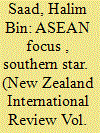

|
|
|
|
|
| Summary/Abstract |
Halim bin Saad provides a Malaysian perspective on New Zealand’s role in South-east Asia.
|
|
|
|
|
|
|
|
|
|
|
|
|
|
|
|
| 2 |
ID:
101927
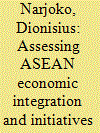

|
|
|
| 3 |
ID:
065764


|
|
|
| 4 |
ID:
091978
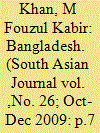

|
|
|
|
|
| Publication |
2009.
|
| Summary/Abstract |
The global recession could not have come at a less inopportune time for Bangladesh.The economy suffered shocks on both domestic and foreign fronts in FY08'. Domestically Bangladesh experienced two rounds of floods and was hit by the catastrophic major cyclone Sidr' which resulted in a huge loss of life and destruction of infrastructure, property and crops.
|
|
|
|
|
|
|
|
|
|
|
|
|
|
|
|
| 5 |
ID:
190401
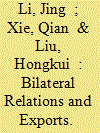

|
|
|
|
|
| Summary/Abstract |
This paper investigates the effect of bilateral relations on exports using data from Google Global Data. It finds that bilateral relations significantly reduced the negative effect of cultural distance on exports, indicating that they can promote exports by reducing trade costs. The paper finds that higher average Goldstein scores of events correlated with more exports and that bilateral relations had a larger effect on trust-intensive products, indicating that positive relations built trust and decreased the emotional distance between trading partners. The results also show that bilateral relations promoted exports at both the intensive and extensive margins but with a greater effect on the latter. Finally, bilateral relations had a greater positive effect on developing countries than on developed ones. The results were qualitatively unchanged when endogeneity issues and robustness concerns were considered.
|
|
|
|
|
|
|
|
|
|
|
|
|
|
|
|
| 6 |
ID:
134025


|
|
|
|
|
| Publication |
2014.
|
| Summary/Abstract |
The paper presents an analysis of the factors explaining the export performance of firms in the defence sector. We focus on the case of Norway, and make use of two complementary methodologies: the first is based on econometric firm-level data analysis for the whole population of defence companies, and the second is based on qualitative case study research on the three most important defence export products (weapon stations, ammunition and electronics). Our empirical results highlight the importance of four major success factors for exporting firms: (1) the participation in offset agreements; (2) the ability to focus on their set of core competencies; (3) their R&D activities and interactions with the public S&T system; and (4) demand opportunities and, relatedly, user-producer interactions.
|
|
|
|
|
|
|
|
|
|
|
|
|
|
|
|
| 7 |
ID:
119788


|
|
|
|
|
| Publication |
2013.
|
| Summary/Abstract |
This article investigates the causal relationship between public policies and exports of renewable energy technologies using panel data from 18 countries for the period 1991-2007. A number of panel unit root and cointegration tests are applied. Time series data on public policies and exports are integrated and cointegrated. The dynamic OLS results indicate that in the long run, a 1% increase in government R&D expenditures (RAD) increases exports (EX) by 0.819%. EX and RAD variables respond to deviations from the long-run equilibrium in the previous period. Additionally, the Blundell-Bond system generalized methods of moments (GMM) is employed to conduct a panel causality test in a vector error-correction mechanism (VECM) setting. Evidence of a bidirectional and short-run, and strong causal relationship between EX and the contribution of renewable energy to the total energy supply (CRES) is uncovered. CRES has a negative effect on EX, whereas EX has a positive effect on CRES. We suggest some policy implications based on the results of this study.
|
|
|
|
|
|
|
|
|
|
|
|
|
|
|
|
| 8 |
ID:
092426
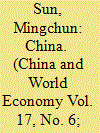

|
|
|
|
|
| Publication |
2009.
|
| Summary/Abstract |
This paper investigates the reasons behind the resilience of China's economy to the global financial tsunami. China's economy is lowly leveraged in its banking, household, public and external sectors and, therefore, is less plagued by the global deleveraging than most developed economies. Chinese domestic sectors have improved significantly over the past decade, giving them larger capacity to cope with external shocks than during the Asian financial crisis a decade ago. Contrary to the conventional wisdom that China's economic growth is highly dependent on exports, we find that the main growth engine for China is domestic demand. Destocking, rather than falling exports, was the main cause of the sharp economic slowdown in China in late 2008 and early 2009. Therefore, the global economic slowdown should have limited impact on China's economy. We forecast a sustained economic recovery in China in 2009-2011, with real GDP growth exceeding 10 percent in 2010.
|
|
|
|
|
|
|
|
|
|
|
|
|
|
|
|
| 9 |
ID:
087648
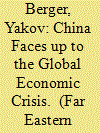

|
|
|
|
|
| Publication |
2009.
|
| Summary/Abstract |
China's growing involvement in the global economy and politics brings it considerable benefits. China gets unrestricted access to world markets for goods and services to supply to, to natural resources and fuels, new technologies and modern managerial know-how, and to international organizations that adopt decisions critical to China's development. All these benefits are acquired at the cost of the country's rising dependence on worldwide developments, market ups and downs, and even worldwide cataclysms.1 The current global financial and economic crisis shows this beyond a shadow of doubt. Accordingly, debates are erupting now and then in China about the balance of gain and loss; about the best way to use the advantages of being involved in globalization and to avoid its most destructive consequences; and also about what is needed to maintain the country's economic and political sovereignty and security without fencing itself off from the rest of the world, but instead take the position of a responsible participant and agent of world history.
Crises in the free-market economy that China is determined to build are certainly unavoidable. The key issue is then to realize that the market, the principal advantages of which are higher competitiveness of enterprises, the state itself, and individuals, cannot correct its inevitable deficiencies all by itself. While promoting a free-market economy, therefore, China is seeking to keep very power-
|
|
|
|
|
|
|
|
|
|
|
|
|
|
|
|
| 10 |
ID:
093847
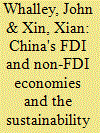

|
|
|
|
|
| Publication |
2010.
|
| Summary/Abstract |
This paper presents and assesses of the contribution of inward FDI to China's recent rapid economic growth using a two stage growth accounting approach. Recent econometric literature focuses on testing whether Chinese growth depends on inward FDI rather than measuring the contribution. Foreign Invested Enterprises (FIEs), often (but not exclusively) are joint ventures between foreign companies and Chinese enterprises, and can be thought of as forming a distinctive subpart of the Chinese economy. These enterprises account for over 50% of China's exports and 60% of China's imports. Their share in Chinese GDP has been over 20% in the last two years, but they employ only 3% of the workforce, since their average labor productivity exceeds that of Non-FIEs by around 9:1. Their production is more heavily for export rather than the domestic market because FIEs provide access to both distribution systems abroad and product design for export markets. Our decomposition results indicate that China's FIEs may have contributed over 40% of China's economic growth in 2003 and 2004, and without this inward FDI, China's overall GDP growth rate could have been around 3.4 percentage points lower. We suggest that the sustainability of both China' export and overall economic growth may be questionable if inward FDI plateaus in the future.
|
|
|
|
|
|
|
|
|
|
|
|
|
|
|
|
| 11 |
ID:
130973
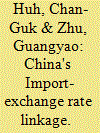

|
|
|
|
|
| Publication |
2014.
|
| Summary/Abstract |
This paper examines how the China-bound exports of Japan and Korea are related to exchange rates, motivated by the fact that processing trade makes up a large proportion of China's trade, and that Japan and Korea are the leading source countries for processing imports. Because processing imports are inputs for exports, the link between such imports and China's exchange rates are ambiguous. We estimate export functions that include China's RMB real effective exchange rates (REER) along with bilateral real exchange rates (BRER) using Johansen's cointegration method and find that the RMB REER significantly affects Japanese and Korean exports to China, even more so than BRER in most cases examined. These two exchange rates appear in the export equations with opposite signs. Subsequently, we use the estimated model to illustrate the importance of accounting for a concurrent change in BRER when analyzing the effects of a hypothetical RMB revaluation on China's trade balances despite the apparently weak imports-BRER linkage.
|
|
|
|
|
|
|
|
|
|
|
|
|
|
|
|
| 12 |
ID:
119152
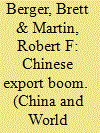

|
|
|
|
|
| Publication |
2013.
|
| Summary/Abstract |
From 2000 to 2007, Chinese exports grew at a phenomenal pace. Our paper uses finely detailed Chinese export data (8-digit Harmonized Commodity Description and Coding System codes) combined with US trade data to explore how this was achieved. Although general explanations such as China's exchange rate policy no doubt played a role, we find that sector-specific stories, effective Chinese industrial policy and fortuitous timing were more critical. The detailed trade data reveal that "new" technology goods, such as cell phones, LCD screens and laptops, played a key role. Finally, we use the data to examine the relationship between Chinese exports and global manufacturing, in particular US manufacturing employment. We find that competition from China in both domestic and foreign markets likely contributed to a significant decline in USA manufacturing employment, but that relatively low US investment and slow GDP growth in the US following the 2001 recession played an equally important role.
|
|
|
|
|
|
|
|
|
|
|
|
|
|
|
|
| 13 |
ID:
129254


|
|
|
| 14 |
ID:
161840
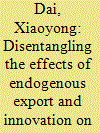

|
|
|
|
|
| Summary/Abstract |
This paper disentangles the effects of export and innovation on firm-level markup and productivity. Based on a large sample of Chinese manufacturing firms, we explicitly account for firms' endogenous export and innovation decisions, and isolate their impacts on firms' future performance, using a propensity score matching approach with multiple treatments. The results indicate that starting to export alone negatively affects firm-level markup and productivity, while starting to innovate alone has a significant positive impact. There is a complementarity between export and innovation in improving firms' performance. The negative effect of starting to export alone on revenue productivity may reflect the decrease of price-cost markup, rather than a change in physical productivity. Our study contributes to explaining puzzling results of exporter performance for China. The results also suggest that firms should establish domestic market power through innovation before turning to export markets.
|
|
|
|
|
|
|
|
|
|
|
|
|
|
|
|
| 15 |
ID:
143412
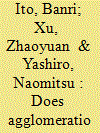

|
|
|
|
|
| Summary/Abstract |
Knowledge spillover from the agglomeration of exporters can reduce the initial costs of exporting faced by other firms and thereby facilitate exports. We use a large dataset of Chinese manufacturing firms to assess whether industrial agglomeration lowers the minimum productivity level required for exporting and whether it increases a firm's probability of exporting. Semi-parametric quantile regressions reveal that the productivity advantage of exporters against non-exporters is markedly smaller in agglomerated regions. Furthermore, a parametric estimation of an export entry model indicates that the agglomeration of incumbent exporters contributes significantly to export participation, although its magnitude is limited. These spillover effects are generated not only by the agglomeration of exporting foreign invested firms (FIFs), but also, more importantly, by that of indigenous Chinese exporters. In fact, the agglomeration of exporting FIFs only contributes to the export entry of FIFs.
|
|
|
|
|
|
|
|
|
|
|
|
|
|
|
|
| 16 |
ID:
154497
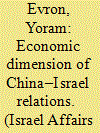

|
|
|
|
|
| Summary/Abstract |
Exploring Sino-Israeli economic relations comprehensively for the first time, this article suggests that this connection allowed the two states to overcome the defence crises that the relationship experienced in the early 2000s. After 2010, as China resolved to enhance relations with Israel, economic ties continued to fulfil a prominent role. Nevertheless, achievements have been mixed. Apparently, investments of Chinese firms in Israel and construction of infrastructure projects in Israel by Chinese corporations are the most successful activities, but they arouse mixed responses in Israel and may have political implications yet to be clarified.
|
|
|
|
|
|
|
|
|
|
|
|
|
|
|
|
| 17 |
ID:
187132


|
|
|
|
|
| Summary/Abstract |
Based upon a sample of 78 firms operating in Indian automotive component industry for the period 2000–2018, this research empirically examines the role of business-group affiliation, overseas investment and technology in determining exports. It applies panel Tobit and Probit model estimated with the maximum likelihood estimator. This research finds that technology imports, firm’s age, overseas investment and affiliation to a business group significantly affect industry’s export performance. However, some variables, such as past R&D intensity, firm’s size and companies with overseas investment and being part of a group have been found to have had a detrimental effect. All these results show that being outward-oriented in terms of overseas investment and being affiliated with a business group makes a significant difference concerning export success.
|
|
|
|
|
|
|
|
|
|
|
|
|
|
|
|
| 18 |
ID:
153053
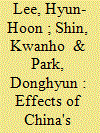

|
|
|
|
|
| Summary/Abstract |
The Chinese economy is slowing down and is in the midst of a structural transformation from export-led and investment-led growth to domestic demand-led and consumption-led growth. While there are widespread concerns among China's trading partners about the effect of the slowdown in China's growth on their exports, China's structural changes are also likely to have a significant impact: for example, China will import fewer machines and more cosmetics. The central objective of the present paper is to empirically examine the effect of China's structural transformation on the exports of East Asian economies, which have close trade linkages with China. We find that economies that have failed to increase the share of consumption goods in their exports to China have suffered larger declines in their quantities of exports to China. In addition, economies that have suffered losses in their shares of China's parts and components imports have faced reductions in their shares in China's total imports.
|
|
|
|
|
|
|
|
|
|
|
|
|
|
|
|
| 19 |
ID:
097364
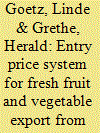

|
|
|
| 20 |
ID:
122454


|
|
|
|
|
| Publication |
2013.
|
| Summary/Abstract |
Research was conducted to find out the effects of exchange rate variability, terms of trade, competitiveness and gross domestic product on the dominant export crop of Ethiopia, coffee. This study employs annual time series data (1992-2010) and uses the autoregressive distributive lag (ARDL) model augmented by the Wald test. The results reveal that exchange rate variability has a negative effect on the export of coffee in the short run, but is insignificant in the long run. This implies that, over time, exchange rate changes in the country have been favouring the export performance of coffee. Regardless of exchange rate variability, the competitiveness of the country, explained by real effective exchange rates, improved, but the price of coffee did not increase relative to the price of imports, which has resulted in deteriorating terms of trade. To improve the worsening terms of trade and benefit from policy changes, export diversification and value addition are possible solutions the country should focus on.
|
|
|
|
|
|
|
|
|
|
|
|
|
|
|
|
|
|
|
|
|